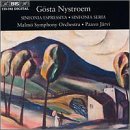| All Artists: Gosta Nystroem, Paavo Järvi, Malmö Symphony Orchestra Title: Nystroem: Sinfonias Members Wishing: 0 Total Copies: 0 Label: Bis Release Date: 3/26/1996 Album Type: Import Genre: Classical Styles: Historical Periods, Modern, 20th, & 21st Century, Symphonies Number of Discs: 1 SwapaCD Credits: 1 UPC: 789368653324 |
Search - Gosta Nystroem, Paavo Järvi, Malmö Symphony Orchestra :: Nystroem: Sinfonias
 | Gosta Nystroem, Paavo Järvi, Malmö Symphony Orchestra Nystroem: Sinfonias Genre: Classical
|
Larger Image |
CD Details |
CD ReviewsA great Scandinavian symphonist Evan Wilson | Cambridge, Massachusetts United States | 03/13/2001 (5 out of 5 stars) "A disciple of Carl Nielsen, the Swedish symphonist Gosta Nystroem developed a powerful idiom which acknowledged the musical trends of his time (1890-1966) without losing his own personality. As a result, it's hard to characterize his music as sounding like anyone else, although one can clearly see that he followed Nielsen's call for more objectivity and less self-indulgence in music.This disc is an excellent introduction to Nystroem's music. The better of the two symphonies on this disc is clearly the Sinfonia Espressiva (No. 2). This is a powerful work built around an opening Lento which begins almost inaudibly and develops into a powerful threnody. The following scherzo is built around a challenging and distinct motif in the winds. Next comes a passacaglia Adagio on a Swedish folk tune which is not at all folksy. In fact, it builds to a powerful peroration before the somewhat Hindemithian fugal finale starts. This builds to a wrenchingly powerful climax before the music ebbs away.The Sinfonia Seria (No. 5) has a somewhat less distinct profile--behaps because the melodic content is not as strong. Composed for strings, percussion and flute, it "sounds" in places like Bartok's masterpiece for a similar group but Nystroem eshews any sense of folk coloring unlike Bartok. There are some very effective moments in the piece, but there are passages where the lack of a distinct melodic element makes the music sound like chromatic noodling.Be that as it may, this is still a disc to get because the Sinfonia Espressiva is a true masterpiece. The music is certainly not Romantic in any sense, but Nystroem does not eschew form and has a pleasing ability to turn memorable melodic phrases. Although there is dissonance and chromaticism, it isn't overwhelming and tiresome as it can be in some 20th century music. So, if you're curious, take the plunge. I think you'll find the Espressiva a piece that will make it back to your player repeatedly. BIS's sound is excellent although the opening bars of both pieces should have been turn up just a little. The performances are fine." Two Gallo-Scandinavian Symphonies Thomas F. Bertonneau | Oswego, NY United States | 03/12/2001 (4 out of 5 stars) "It is useful to know that the Swede Gösta Nystroem (1890-1966) studied in Paris with Vincent d'Indy. In Nystroem's work one hears equal parts of the Nordic and the Gallic temperaments; occasionally, one even detects that penchant for musical severity (or maybe earnestness) that passes from D'Indy's own teacher, César Franck, to all those who submitted to the regimen at the Schola Cantorum. Nystroem's second symphony, his Sinfonia Espressiva (1932), shows some formal resemblance to d'Indy's own Second Symphony (1902/03), especially in its fugal Finale, but overall in what might be called its "ethos." In four movements, Sinfonia Espressiva begins with a Lento for strings backed up in spare appearances by the tympany. In this opening movement, Nystroem develops a series of pregnant motifs heard in the first few bars. The music gradually becomes polyphonic, the motifs being counterpointed against one another in a complicated texture. The Second Movement is a brief Scherzo (Allegro) that adds woodwinds and brass (the horns) to the homogeneous character of the string-band. The Scherzo has a telegraphic urgency to it. In the Third Movement (Adagio), Nystroem returns us to the sobriety of the Lento. The elaborate Fourth Movement (Allegro Risoluto) begins as a passacaglia which gives way to a vigorous fugue about halfway through its ten minutes' or so of playing time. Nystroem's Fifth Symphony, his Sinfonia Seria, comes from thrity years later, and is for strings, flute, and percussion. The title is rich with implications: The atmosphere is indeed "serious," and the technique is (well, sort of) "serial," in that it rigorously develops a few seminal motifs heard at the beginning of the first of two parts aprpoximately equal in duration (about 12.00 and 15.00). The music is "modern" in sound but rather in the way that Ernest Bloch is "modern." (Bloch, like Nystroem, has his roots in the Franck school.) Or sometimes the music of Arthur Honegger comes to mind, especially in the Scherzo of the Espressiva. But Nystroem remains a fundamentally tonal and rather romantic composer (he once described himself as "an incurable romantic") even when he is coming to grips with the severe demands of Stravinskyan or Schoenberigan modernity. Paavo Järvi, whom I take to be the son of Neeme Järvi, leads the Malmö Symphony Orchestra in convincing performances. One of Nystroem's paintings (yes, he was also a painter) adorns the cover of the booklet. The program notes are inexplicably inaccurate, describing the Espressiva as in three, when in fact it is in four, movements. BIS also released a CD of Nystroem's Viola Concerto and his Sinfonia Concertante for Cello and Orchestra, not currently listed by Amazon.com, but still advertised in the BIS catalogued and worth looking for. Recommended."
|

 Track Listings (6) - Disc #1
Track Listings (6) - Disc #1